中西方婚礼习俗
- 格式:ppt
- 大小:6.26 MB
- 文档页数:31
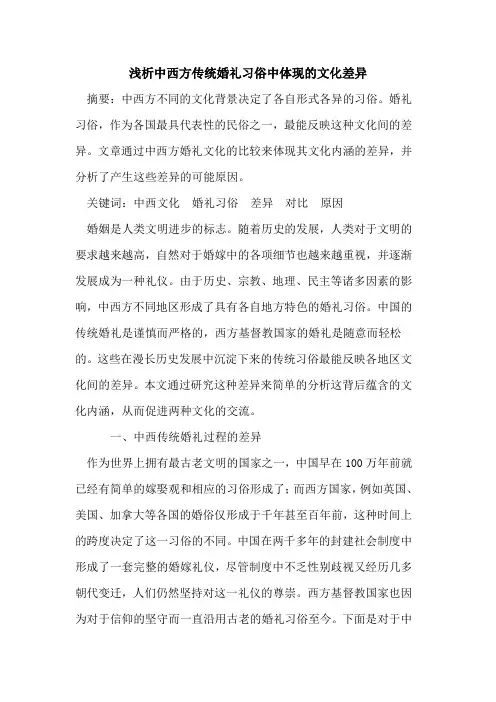
浅析中西方传统婚礼习俗中体现的文化差异摘要:中西方不同的文化背景决定了各自形式各异的习俗。
婚礼习俗,作为各国最具代表性的民俗之一,最能反映这种文化间的差异。
文章通过中西方婚礼文化的比较来体现其文化内涵的差异,并分析了产生这些差异的可能原因。
关键词:中西文化婚礼习俗差异对比原因婚姻是人类文明进步的标志。
随着历史的发展,人类对于文明的要求越来越高,自然对于婚嫁中的各项细节也越来越重视,并逐渐发展成为一种礼仪。
由于历史、宗教、地理、民主等诸多因素的影响,中西方不同地区形成了具有各自地方特色的婚礼习俗。
中国的传统婚礼是谨慎而严格的,西方基督教国家的婚礼是随意而轻松的。
这些在漫长历史发展中沉淀下来的传统习俗最能反映各地区文化间的差异。
本文通过研究这种差异来简单的分析这背后蕴含的文化内涵,从而促进两种文化的交流。
一、中西传统婚礼过程的差异作为世界上拥有最古老文明的国家之一,中国早在100万年前就已经有简单的嫁娶观和相应的习俗形成了;而西方国家,例如英国、美国、加拿大等各国的婚俗仅形成于千年甚至百年前,这种时间上的跨度决定了这一习俗的不同。
中国在两千多年的封建社会制度中形成了一套完整的婚嫁礼仪,尽管制度中不乏性别歧视又经历几多朝代变迁,人们仍然坚持对这一礼仪的尊崇。
西方基督教国家也因为对于信仰的坚守而一直沿用古老的婚礼习俗至今。
下面是对于中西方婚礼不同时间段的不同事项安排的对比。
1.婚礼前1)配偶的选择在选择配偶方面,中国传统婚礼中一个重要的观念就是“父母之命,媒妁之言”。
婚姻双方的当事人并没有选择配偶或拒绝配偶的权利,父母以及在婚姻中扮演重要角色的陌生人——媒人才是婚姻的真正主导者。
即使父母不在了,家中的长辈也会代替父母履行这一职责。
一个家庭选择另一个家庭的第一标准则是“门当户对”,也就是要有同样的社会地位或者同样的财富,其次才是对方的品貌和修养,可见婚姻是一项家庭事务而非个人的事情。
西方国家中,尽管也存在家族与家族之间因为利益的联姻,但结婚还是有着高度自由的。
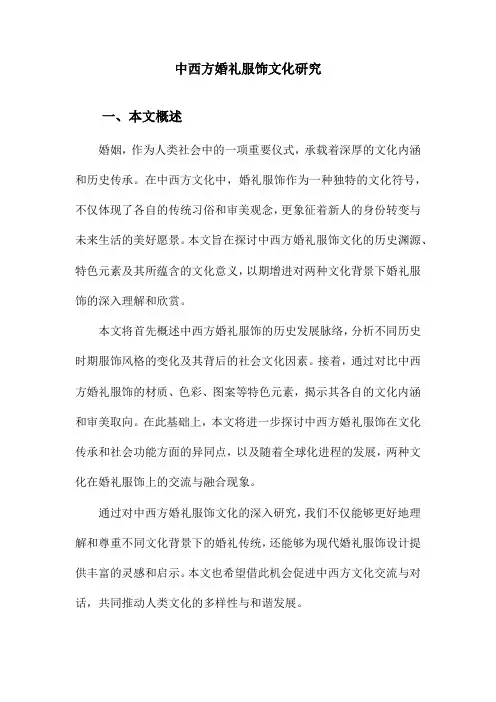
中西方婚礼服饰文化研究一、本文概述婚姻,作为人类社会中的一项重要仪式,承载着深厚的文化内涵和历史传承。
在中西方文化中,婚礼服饰作为一种独特的文化符号,不仅体现了各自的传统习俗和审美观念,更象征着新人的身份转变与未来生活的美好愿景。
本文旨在探讨中西方婚礼服饰文化的历史渊源、特色元素及其所蕴含的文化意义,以期增进对两种文化背景下婚礼服饰的深入理解和欣赏。
本文将首先概述中西方婚礼服饰的历史发展脉络,分析不同历史时期服饰风格的变化及其背后的社会文化因素。
接着,通过对比中西方婚礼服饰的材质、色彩、图案等特色元素,揭示其各自的文化内涵和审美取向。
在此基础上,本文将进一步探讨中西方婚礼服饰在文化传承和社会功能方面的异同点,以及随着全球化进程的发展,两种文化在婚礼服饰上的交流与融合现象。
通过对中西方婚礼服饰文化的深入研究,我们不仅能够更好地理解和尊重不同文化背景下的婚礼传统,还能够为现代婚礼服饰设计提供丰富的灵感和启示。
本文也希望借此机会促进中西方文化交流与对话,共同推动人类文化的多样性与和谐发展。
二、中式婚礼服饰文化中式婚礼,作为中华文化传统的重要组成部分,其服饰文化体现了深厚的民族特色与历史内涵。
在中式婚礼中,新人所穿着的婚服往往承载了家族、亲友与社会的期望与祝福,同时也是对中华文化的传承与展现。
中式婚礼的婚服通常采用传统的汉服或唐装样式,以红色为主色调。
红色在中国文化中象征着吉祥、喜庆与繁荣,是婚礼中不可或缺的元素。
男子常穿对襟长袍,外罩马褂,头戴瓜皮帽,脚蹬布鞋,展现出一种庄重而又不失风度的气质。
女子则穿着旗袍或凤冠霞帔,展现出婉约与典雅之美。
旗袍紧贴身形,曲线优美,展现出女性的曼妙身姿;而凤冠霞帔则更显华丽,凤冠代表着女性的高贵与尊荣,霞帔上的刺绣则展示了精湛的手工艺与深厚的文化内涵。
中式婚礼的婚服上常常绣有各种吉祥图案,如龙凤呈祥、喜结连理、鸳鸯戏水等,这些图案不仅美观,而且寓意深刻。
龙凤是中华文化中的神兽,代表着力量与智慧,而鸳鸯则是忠贞不渝的爱情象征。
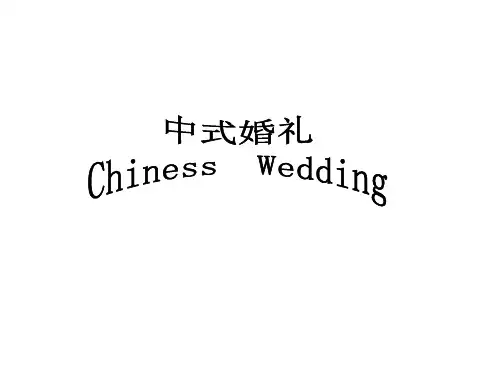
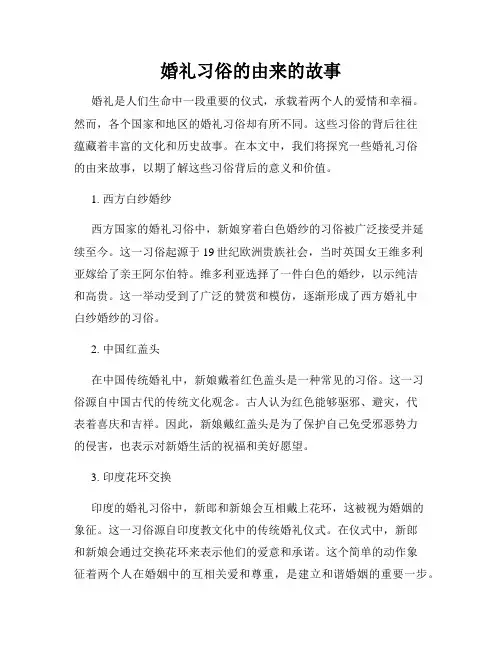
婚礼习俗的由来的故事婚礼是人们生命中一段重要的仪式,承载着两个人的爱情和幸福。
然而,各个国家和地区的婚礼习俗却有所不同。
这些习俗的背后往往蕴藏着丰富的文化和历史故事。
在本文中,我们将探究一些婚礼习俗的由来故事,以期了解这些习俗背后的意义和价值。
1. 西方白纱婚纱西方国家的婚礼习俗中,新娘穿着白色婚纱的习俗被广泛接受并延续至今。
这一习俗起源于19世纪欧洲贵族社会,当时英国女王维多利亚嫁给了亲王阿尔伯特。
维多利亚选择了一件白色的婚纱,以示纯洁和高贵。
这一举动受到了广泛的赞赏和模仿,逐渐形成了西方婚礼中白纱婚纱的习俗。
2. 中国红盖头在中国传统婚礼中,新娘戴着红色盖头是一种常见的习俗。
这一习俗源自中国古代的传统文化观念。
古人认为红色能够驱邪、避灾,代表着喜庆和吉祥。
因此,新娘戴红盖头是为了保护自己免受邪恶势力的侵害,也表示对新婚生活的祝福和美好愿望。
3. 印度花环交换印度的婚礼习俗中,新郎和新娘会互相戴上花环,这被视为婚姻的象征。
这一习俗源自印度教文化中的传统婚礼仪式。
在仪式中,新郎和新娘会通过交换花环来表示他们的爱意和承诺。
这个简单的动作象征着两个人在婚姻中的互相关爱和尊重,是建立和谐婚姻的重要一步。
4. 日本酒碗交换日本传统婚礼中,新郎和新娘会举行酒碗交换的仪式。
这一习俗源自日本古代的贵族社会。
在仪式中,新郎和新娘分别举起酒碗,交换酒碗喝下对方的酒。
这是为了象征两人之间的契约和誓约。
而且,这也是一种向来宾表达新郎和新娘对他们参与婚礼的感激之情的方式。
5. 非洲豪华婚礼非洲一些部落和民族有着非常奢华的婚礼习俗。
比如,在尼日利亚的豪斯族和也鲁巴族中,举办婚礼时会变得非常盛大和浓烈。
婚礼上会有音乐、舞蹈和传统的仪式,还有华丽的服饰和装饰品。
这些奢华的婚礼习俗反映了这些部落和民族对婚姻的重视和社区团结的观念。
总结起来,婚礼习俗的由来故事多种多样,背后承载着不同国家和地区的文化传统和历史背景。
通过了解和尊重这些习俗的起源和意义,我们可以更好地理解这些文化,促进跨文化的交流和理解。
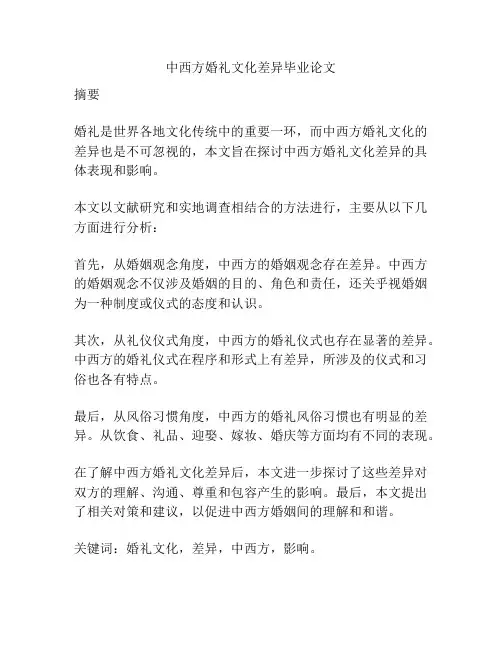
中西方婚礼文化差异毕业论文摘要婚礼是世界各地文化传统中的重要一环,而中西方婚礼文化的差异也是不可忽视的,本文旨在探讨中西方婚礼文化差异的具体表现和影响。
本文以文献研究和实地调查相结合的方法进行,主要从以下几方面进行分析:首先,从婚姻观念角度,中西方的婚姻观念存在差异。
中西方的婚姻观念不仅涉及婚姻的目的、角色和责任,还关乎视婚姻为一种制度或仪式的态度和认识。
其次,从礼仪仪式角度,中西方的婚礼仪式也存在显著的差异。
中西方的婚礼仪式在程序和形式上有差异,所涉及的仪式和习俗也各有特点。
最后,从风俗习惯角度,中西方的婚礼风俗习惯也有明显的差异。
从饮食、礼品、迎娶、嫁妆、婚庆等方面均有不同的表现。
在了解中西方婚礼文化差异后,本文进一步探讨了这些差异对双方的理解、沟通、尊重和包容产生的影响。
最后,本文提出了相关对策和建议,以促进中西方婚姻间的理解和和谐。
关键词:婚礼文化,差异,中西方,影响。
AbstractWedding is an important part of cultural traditions in different parts of the world, and the differences in wedding culture between China and the West cannot be ignored. This paper aims to explore the specific manifestations and impact of cultural differences in wedding culture between China and the West.This paper adopts the method of literature research and field investigation. The analysis is mainly from the following aspects:Firstly, from the perspective of marriage concept, there are differences in marriage concepts between China and the West. The concept of marriage in China and the West not only involves the purpose, role, and responsibility of marriage, but also the attitude and understanding of marriage as an institution or ceremony.Secondly, from the perspective of ceremony and etiquette, there are significant differences in wedding ceremonies between China and the West. Wedding ceremonies in China and the West differ in procedure and form, and the rituals and customs involved in weddings are also different.Lastly, from the perspective of customs and habits, there are also obvious differences in wedding customs and habits between China and the West. There are different expressions in eating, gifts, bridegroom pick-up, dowry, and wedding celebrations.After understanding the cultural differences between China and the West, this paper further explores the impact of these differences onunderstanding, communication, respect, and tolerance between the two sides. Finally, this paper puts forward relevant countermeasures and suggestions to promote understanding and harmony between Chinese and Western marriages. Keywords: wedding culture, differences, China and the West, impact.。
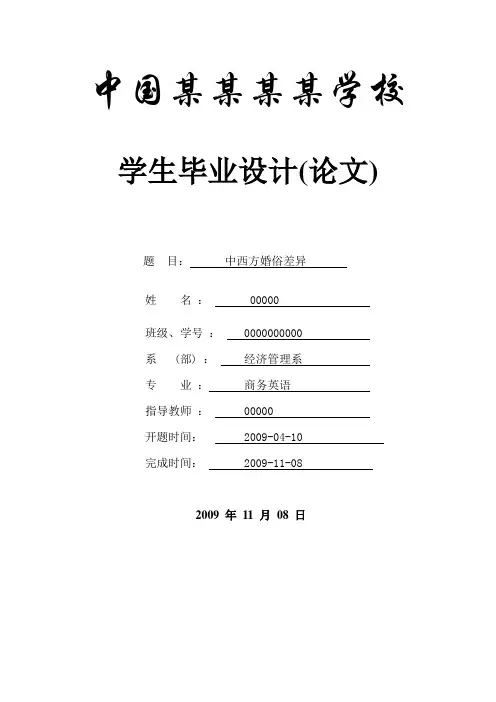
中国某某某某学校学生毕业设计(论文)题目:中西方婚俗差异姓名: 00000班级、学号: 0000000000系 (部) :经济管理系专业:商务英语指导教师: 00000开题时间: 2009-04-10完成时间: 2009-11-082009 年11 月08 日目录课题中西方婚俗差异一、课题(论文)提纲二、内容摘要三、参考文献On Differences of Marriage CustomsBetween China and Western Countries00000000Abstract:There are many procedures in Chinese Marriage custom. The book Propriety and Ceremony,which records earliest wedding ceremony, says that marriage includes six etiquettes, namely, proposing, asking the name, asking for fortune, sending betrothal presents to the girl's family, discussing the date of marriage and meeting the bride. In western marriage, there are four procedures. They are proposal, changing surnames, choosing the day and holding the wedding. As the different religions, cultural origins, marriage concepts and geographies, there are many differences existing in the two kinds of Marriage customs. In Chinese Marriage custom, the matchmaker functions almost all the time and youths have no right to choose and women are not on an equal footing with men. By contrast, in western Marriage custom, the priest functions and the youths have legal right to choose whom they want to marry and men and women are equal. There also exist common things in the two sides. They have been maintained for thousands of years. But in recent years (especially after the founding of modern China), people havetended to discard some of the details and advocate simplified marriage procedures and wedding ceremonies.key words:Marriage custom; differences; reasonsIntroductionMarriage is formed in a long historical evolution of the marriage custom in a nation. It is the regularity of the activities that restrains people's awareness of marriage. Marriage custom’s binding does not depend on the law, and it can not rely on science tests neither, but on the force of habit, traditional culture and national psychology. During the development of human history, the institution of marriage and family system has experienced different processes of development. Human have experienced group marriage, the dual system of marriage and individual marriage system (monogamy). As a union of a man and a woman and a family formation stage, marriage includes not only marriage, but also the preparation phase for the marriage and the performance stage after the festivities. It runs through the whole process of life. These customs, as a national symbol and cultural development, plays a very important role in ethnic studies and the history of mankind.China is a country with an ancient civilization and a long history, and many customs. Among so many customs, there is a particular marriage custom. This custom goes through various and long stages of development from ancient simple wedding ceremony to later complex ceremony, from feudal marriage custom to the modern free marriage custom. During these courses, people’s ideas are progressing, though we can not say that their ideas are up to the top of mankind’s ideas in all over the world at all over the time because there are still backward ideas existing in many places, in many people’s mind and they maybe will still exist for a long time. However, they are up to the top of mankind’s ideas in a certain stage of the uninterrupted development of ideas.Greek civilization is the base of western culture. Britain plays an important role in western history and western culture, and of course marriage custom.Comparing with each other, they are different in many aspects such as in right aspect and in freedom aspect and there are many reasons that result in these differences such as cultural reason and geographical reason.1.Chinese Marriage CustomLike other folk, marriage custom has the same developmentand evolving process. In the early days of humanity, the human relationship in a very long period of time still carried the irregular relations like the animal world. There was no marriage at all, if suggest some, the only "arbitrary marriage."In China, marriage has gone through for a long time. As a most grand etiquette, it has always been a high degree of attention. To control the marriage, the family and the whole society, since the beginning of Zhou Dynasty, Chinese marriage should comply with six procedures, which is the so-called "six etiquettes." And Later in Tang and Ming Dynasty in China, marriage also complied with the "six etiquettes". As time goes by, although many wedding customs experienced various changes "Six etiquettes" as the basic pattern has not changed much. It is still essential and core in marriage custom.. Marriage has changed much today, but in many places, there still remains traditional marriage custom.In feudal society, a marriage would be decided not by the youths’ love, but by their parents' desires. Only after a matchmaker's introduction and when parents considered the two family conditions were similar and could be matched, would the marriage procedures went forward. Conditions that should betaken into consideration included wealth and social status. If a boy's family was well-off or an official family, his parents would never permit him to marry a girl from a poor family. Essential to the marriage process were the commonly recognized 'three Letters and six etiquettes'. The three letters were the betrothal letter, the gift letter with a gifts list and the wedding letter used on the day the bridegroom met his bride at her home.The book propriety and ceremony, which records earliest wedding ceremony, says that marriage, usually, involves six necessary procedures, namely, proposing, asking the name, asking for fortune, sending betrothal present to girl's family, discussing date of marriage and meeting the bride.1.1 ProposingProposing is the first etiquette in marriage and is the first meet between the members in the two families. Thus, it is very important. Using a common expression, it is making an offer of marriage to another family on behalf of the son or daughter.If the parents thought that the girl could be the daughter-in-law in old times, they would ask a matchmaker for sending the gifts and bring the son and the girl together. Ifthe girl’s parents also agreed on the marriage, they would accept the gifts. People usually used a wild goose when sending the gifts. Because the wild gooses could fly to the south or the north according to the seasons and they would never change it which implied the woman would be punctual and also because when the wild gooses flied they were in a row and when they stopped they were in a line which implied that woman should comply with the marriage rules and arrange in order that one should not breach it.1.2 Asking the NameIt aims to ask for girl’s name and pray.In ancient times the girl’s name would not be known by other people until the girl was in an age of marriage.First, one must have the matchmaker and inform of the man’s family through a card. And the man’s family would lastly receipt for postal remittance. Thus it can be seen that “asking the name” not only meant that the man’s family wanted to know the girl’s name, but also wrote down the woman’s birthday and Eight-characters (in four pairs denoting the time, date, month and year of a person’s birth, each pair consisting of one Heavenly Stem and one Earthly Branch, used in fortune-telling). If the birthday and Eight-characters were not harm the man, theman’s family would lastly receipt for postal remittance. Sometimes the woman’s parents also wrote down the official position of the woman’s great-grandpa, grandpa and father and the dowry that could be supplied. What’s interesting is that during this progress it was the matchmaker that functioned, not the man’s family or the woman’s family. Matchmaker was also important in the other procedures. In traditional Chinese marriage, people believed “behest of the parents and proposal of a matchmaker”. That’s why many marriages in the past were arranged by parents and matchmakers. Matchmaker’s proposal was the marriage’s valid basis in Tang dynasty.It has been simplified today. Many marriage does not nee this process.1.3 Asking for FortunedAfter asking the name, the bridegroom’s side had got the woman’s birthday and Eight-Characters and they went to consult a fortune-teller then which was called “asking for fortune”. It included two aspects of contents. One was consult the female virtues. Ancient people regarded female virtues as the most important one in the gospel of three obedience that were obedience to one’s father before marriage, to one’s husband after marriage, and to one’s son after one’s husband’s deathand four virtues that was morality, proper speech, modest manner, and diligent work for a woman according to Confucian ethics.Zhong lichun, Zhuge Liang’s wife (Zhuge Liang was a statesman and strategist in the period of the Three Kingdoms, now a symbol of wisdom in Chinese folklore) was famous for her ugliness, wisdom and high female virtues. A man in old times always had many wives. In order to solidifying and stead in the family, people paid much attention to female virtues. Hence there was the saw “Marry wife is marrying virtues and take a concubine is marrying appearance”.The other one was consult good or bad luck. If they were not fit for each other in Eight-Characters according to the birthday and what’s more, the woman would harm the man, the result was that this marriage would not be held and would be cancelled. If the result was fit for each other and moreover the woman would make the man prosperous, the man’s side would inform the woman’s side through the matchmaker and send the betrothal gifts and exchange cards. Thus the marriage was actually decided to be held.1.4 Sending Betrothal Presents to the Girl’s FamilyThe book propriety and ceremony wrote by the scholars inHan dynasty regards it as sending money. If there is no receipt of gifts, there is no marriage. Hence whether receipt the gifts or not is the implication of the agreement of the marriage by the woman’s side.The significance of it includes two aspects of meaning. One is the thanks for the woman’s parents because the parents feed up her. The other is help the woman’s family prepare for dowry.1.5 Discussing the Date of MarriageIn the past, the bridegroom’s side decided the lucky day and sent the matchmaker to inform of the woman’s family. People paid much attention to the marriage time. They usually had a person looked at the almanac or asked for fortune. They liked having marriage in spring or autumn because spring was the time that everything comes back to life and time when spring was changing into summer and was favor to pregnant with new life; autumn was the season of harvest. After the labor for a year, people had enough money to hold the marriage.Nowadays, it is also an important event. People pay many attentions to it.1.6 Meeting the BrideThe marriage is finally held after the five procedures. In the past, the bridegroom wore wedding suit, riding on a horse, and guided the bridal sedan chair to marry the bride on the day.And the bride wore a red cheongsam waiting for the bridegroom. Now, the bridegroom wares western suit, and the bride wares wedding dress and usually in a car.2. Western Marriage CustomIn the middle ages children were married at a young age. Girls were as young as 12 when they got married, and boys as young as 14. The arrangement of the marriage was based on monetary worth. The family of the girl who was to be married gave a dowry, or donation, to the boy she was to marry. The dowry went with her when the marriage was held and stayed with the boy forever after the marriage. After the marriage was arranged, a wedding notice was posted on the door of the church. The notice was put up to ensure that there were no grounds for prohibiting the marriage. The notice stated who was to be married, and if anyone knew any reasons that the two could not marry, they were to come forward with the reason. If the reason was a valid one the wedding would be prohibited.There are many reasons for prohibiting a marriage. One reason was consanguinity, if the two were too closely related. If the boy or the girl had taken a monastic or religious vow, the marriage was also prohibited. Sometimes widows or widowers took vows of celibacy on the death of their spouse, and laterregretted doing so when they could not remarry. Other reasons which also prohibited marriage, but were not grounds for a divorce, were rape, adultery, and incest. A couple could not be married during a time of fasting, such as lent or advent. Nor could a couple be married by someone who had killed someone.In the middle ages there were few reasons the wedding could be dissolved. One reason was if either the man or woman were not of legal age, 12 for girls and 14 for boys. If the husband or wife had previously made a religious or monastic vow or were not Christian, the marriage would be dissolved. The last reason a marriage could end was if the woman, not the man, was incapable of sexual relations.2.1 ProposalWhen the prospective groom had obtained his father’s consent to marry, a formal marriage proposal had to be made. The prospective groom did not propose in person but sent his friends or members of his family to represent his interest to the prospective bride and her family. If they saw a blind man, a monk or a pregnant woman during their journey, it was believed that the proposal would not be accepted as these signs were thought to bring bad luck. If, however, they saw nanny goats, pigeons or wolves, this was a good omen which would bring goodfortune to the marriage.During Medieval times in western countries, the man proposed by leaving a hawthorn branch at the door of his beloved on the first of May. By leaving the branch at the door she accepted his proposal. She made known her refusal by replacing the hawthorn branch with a cauliflower.2.2 Changing SurnamesIt was thought unlucky for a woman to marry a man whose surname began with the same letter as hers. The sentiment was summarized in the following thyme: To change the name and not the letter is to change for the worst and not the better. The bride should not practice writing her new name before the wedding. This was thought to bring bad luck by tempting fate.2.3 Choosing the DayAlthough most weddings now take place on a Saturday, it was considered unlucky in the past. Fridays were also considered unlucky particularly Friday the 13th. The famous old rhyme advised a wedding in the first half of the week:Monday for wealthTuesday for healthWednesday the best day of allThursday for lossesFriday for crosses (= funerals)Saturday for no luck at allAdvice on which month to marry in was given by the following rhyme:Married when the year is new, he'll love, kind and true. When February birds do mate, you neither wed nor dread your fate.If you wed when March winds blow, joy and sorrow both you'll know.Marry in April when you can, Joy for Maiden and for Man. Marry in the month of May, and you'll surely rue the day. Marry when June roses grow, over land and sea you'll go. Those who in July do wed, must labor for their daily bred. Whoever wed in August be, many a change is sure to see Marry in September's shrine, your living will be rich and fine. If in October you do marry, love will come but riches tarry. If you wed in bleak November, only joys will come, remember. When December snows fall fast, marry and true love will last. Marry in May and you'll live to rue the dayMay had been considered an unlucky month to marry in for a number of reasons. In Pagan times the Feast of the Dead and the festival of the goddess of chastity both occurred in May.The advice was taken more seriously in Victorian times than it is today. In most Churches the end of April was a busy time for weddings as coupes wanted to avoid being married in May. Queen Victoria was thought to have forbidden her children from marrying in May.June was considered to be a lucky month to marry in, because it was named after Juno, the Roman goddess of love and marriage.The summer as a whole was considered a good time to marry and this was partly to do with the sun's association with fertility. In Scotland one popular custom was for the bride to "walk with the sun" to bring her good. She would walk from east to west on the south side of the church and then continue walking around the church three times.2.4 Holding the WeddingThe wedding ceremony was finally held.The church ceremony in the middle ages took place outside the church door before entering the church for a nuptial mass. During the ceremony in front of the church doors the man stood on the right side and the woman stood on the left side, facing the door of the church. “The reason was that she was formed out of a rib in the left side of Adam.” The priest began by asking if anyone knew of any reason the couple should not be married. He also asked thisof the man and woman so they might confess any reasons for prohibiting their marriage.The ceremony proceeded with the priest saying, “N (amen) wilt though have this woman to thy wedded wife, wilt the love her, and honor her, keep her and guard her, in health and in sickness, as a husband should a wife, and forsaking all others on account of her, keep thee only unto her, so long as ye both shall live?” Then the priest, changing the wording of “as a husband should a wife”, asked the same of the woman. Both the man and the woman should answer by saying” I will.” At this time the woman was given by her father. The wedding continued with the saying of vows. Both the man and the woman, with the exception of the words wife and husband, said, “I N. take thee N. to my wedded wife, to have and to hold from this day forward, for better, for worse, for richer, for poorer, in sickness, and in health, till death do us part, if the holy church will ordain it. And thereto I plight thee my troth.” At this time the ring exchange occurred. They bowed their heads and the priest gave them a blessing. As husband and wife they entered the church, where they knelt before the altar. At the altar the priest gave a prayer and a blessing, thus ending the marriage ceremony.If the bridegroom and bride did not belong to England ofChurch, they must use the second marriage form, according to the law, that was go to the marriage registrant to hold a secular marriage ceremony.3. Differences between themIt is clear that Chinese marriage custom and western marriage custom differ from each other in many aspects. In Chinese marriage custom the matchmaker has many functions and youths have no right to choose and women are not on an equal footing with men. By contrast, in western marriage custom, the priest has functions and the youths, particular the man, have legal right to choose whom they wanted to marry and men and women are equal.3.1 Different Marriage MediaMatchmaker and priest are different. Matchmaker has many functions. Almost in every process in marriage in old times, the matchmaker would attend. First, it was the matchmaker that introduced a man to a woman or a woman to a man, most the former. If matchmaker did not introduce them to each other, they would not know about each other for ever. If some accident event happened, that is they knew each other not through the matchmaker, they would be called “committing adultery with each other “or “a thief if a man and a whore if a woman”.Second, the other procedures after introduction in marriage were also done by the matchmaker.There are three conditions in marriage in old China that were the matchmaker’s proposals, six gifts and meet, people kept honoring the ancestors as the center in these three conditions. The regulation of listening to matchmaker’s proposals was the rule that people must abide by. The reason was not only the function the matchmaker had in society, but also the meaning that the matchmaker had in later generation reproduction.In modern times, matchmaker still has some of above functions such as the function of introduction.Priest does not always function. It is his duty only when he hosts the wedding ceremony. It was not the priest who introduces the man to the woman or the woman to the man.In Christian’s opinions, wedding ceremony is considered as an important way to get god’s save and wedding ceremony is a very important part of marriage. Priest plays an essential role in it. And marriage is not valid, unless the ceremony is hosted by priest. There are three conditions in marriage too. First, there should be some correct things that is used when go to church; second, correct means to go to church especiallycorrect reading prayer book; third, correct motive to go to church which emphasizes action by church’s order. It can be seen that church is important in western people’s eyes, so the priest is necessary when holding a marriage. And marriage is tinged with mystery because of these conditions.3.2 Differences on freedomIn old China, people looked at the country and society as the standard, thus, “behest of parents” played an absolute important role in marriage. It was the principles of heaven and earth—right and proper when parents dealt with the son's or daughter's marriage only by their own opinions. Marriage in China was arranged by family. “Behest of parents and proposals of matchmaker” decided everything about marriage. Usually the husband and the wife did not meet each other before getting married. They did not know what their husband or wife liked. Even sometimes they did not know the names of each. If they did not agree the marriage, it was no use because the right of decision belonged to their parents. The marriage would still be held. The youths are not free when chose the lover in some places even today.Marriage marks the beginning of complete independence from the parents. According to the English law, no one was allowedto get married under the age of sixteen. Marriage between the age of sixteen and eighteen must have the parents’ consent. But when the girl was over eighteen, she was free to choose her love. Youths in Britain were relatively free. In Britain, church pointed out “agreement principle” which pointed out that the marriage was valid only when the two persons involved in marriage expressed freely and openly in front of at least two chief witness at wedding ceremony; the marriage was not valid when there existing misunderstanding or force in marriage. Under this “agreement principle”, the father should listen to the daughter’s suggestion, and the father should not force the daughter to marry with the man whom she did not want to marry. Thus, it can be seen from this point that, one’s willing was superior to anything.3.3 Differences on rightChinese men were hold up as “sky” and women were considered as “earth” in old times. Sky was superior to earth in old people’s eyes. And women must comply with three obedience and four virtues. But man could have a wife and many concubines. In north of China in some places, husband and wife are still unequal.The Bible says that husband should respect wife becauseboth of them are blessed by God. And it emphasizes that the relations between husband and wife should include duty.3.4 Different Purposes of MarriageThe main purpose of getting marriage in China is to continue the male offspring. The so-called “there are three forms of filial impiety, of which the most serious is to have no heir”reflects the importance to serve ancestors. And the filial piety is traditional virtues.In western countries, they are influenced deeply by religion, especially the Christianity. They think that it is the God who has created marriage. There are three purposes of the marriage created by God. First, the couple is lifelong companion with each other; they serve God together. Then get married, start career and produce an heir to carry on the pious descendants. The final purpose is carrying on the pious descendants to serve to God. So they do not stress the blood relationship. They can remedy the defect of non-child by adopting other children.4. Reasons for the Differences4.1 ReligionsAmong all the religion by which people seek to worship, Christianity is by far the most influential in the west. Everyphase of man’s life is touched by this religion, so much so that it has become part and parcel of western culture. British dominant religious belief is Christian faith; or rather the U.K. is a country of Christianity.Bishop ordered marriage law as the fourth chapter in 1234. After issuing the law, it was carried on under the strong church control. In 1917, the marriage law referred: wedding ceremony should be held by priest or at least two witness; the willing should be true and not be forced.Most Chinese people believes Buddhism which advocates “why and because relationship”. In this point of view, sky is the reason, and earth is the result; parents are the reason, and sons or daughters are the result; husband is the reason, and wife is the result.4.2 Cultural OriginsTraditional Chinese traditional marriage custom was characterized by a distinctive patriarchal clan system. “Three obedience and four virtues” decided that women should become an appendage to the men and be subordinated to the family interest. It was also characterized by strong feudal political color. Marriage sometimes was a kind of ways to ally in political. The policy of cementing friendly relations throughpolitical marriages was a typical example in history. The traditional marriage custom was influenced deeply by Confucianism.There sill exists differences between males and females in marriage custom today. This phenomenon is also caused by the traditional Chinese culture.Western marriage custom is influenced deeply by religion, however, which emphasizes both men and women are God’s sons and daughters, so they are equal unlike Chinese who pay more attentions to boys. Western people consider girls are also the fruit of love.4.3 Marriage ConceptsChinese people once thought that marriage was a kind of ways to increase families, offspring and protect and enhance family’s reputation and position. Marriage would add a girl of a clan other than one’s own, so marriage was looked as the important event of family but not one’s own event. The love between the man and the woman was not the first condition of marriage. Today the marriage concepts have not changed much especially in some backward places. The aim of getting marriage for them is till to increase families, offspring and protect and enhance family’s reputation and position.In western countries, marriage is the love’s home to return to. The aim of marriage is to make the woman and the man live together all the life. It is the personal affair. They have no duty to increase family, offspring and protect and enhance family’s reputation and position. The marriage just make them live together. Thus those westerners stress feeling not the family’s interest or reputation when they are choosing lover.4.4 GeographiesBritain is over one thousand kilometers from south to north. Its coastline runs about ten thousand kilometers, making it one of the countries with the longest coastlines in the world. In Britain no place is over one hundred and twenty kilometers from the sea. During the fight with the sea, British people feel the strong force of the nature that is difficult to control. Thus they believed God. They think God is omnipotent and they respect God very much.China’s geography is extremely varied and complex, including mountains, plateaus, plains, grasslands, basins, hills, islands, desert, glaciers, and frozen earth. Mountain areas cover about two-thirds of the total land area. This geography decides that Chinese people live mainly by farming and live in groups, and later formed the patriarchal clan system with rigidly stratified. This makes Chinese people respect the。

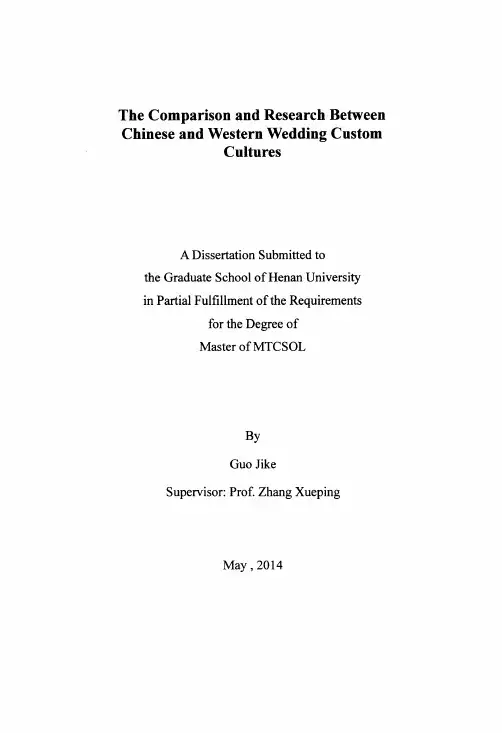
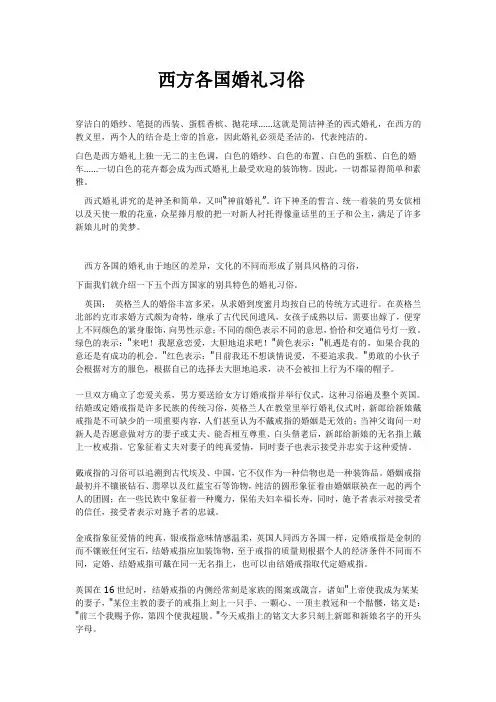
西方各国婚礼习俗穿洁白的婚纱、笔挺的西装、蛋糕香槟、抛花球……这就是简洁神圣的西式婚礼,在西方的教义里,两个人的结合是上帝的旨意,因此婚礼必须是圣洁的,代表纯洁的。
白色是西方婚礼上独一无二的主色调,白色的婚纱、白色的布置、白色的蛋糕、白色的婚车……一切白色的花卉都会成为西式婚礼上最受欢迎的装饰物。
因此,一切都显得简单和素雅。
西式婚礼讲究的是神圣和简单,又叫“神前婚礼”。
许下神圣的誓言、统一着装的男女傧相以及天使一般的花童,众星捧月般的把一对新人衬托得像童话里的王子和公主,满足了许多新娘儿时的美梦。
西方各国的婚礼由于地区的差异,文化的不同而形成了别具风格的习俗,下面我们就介绍一下五个西方国家的别具特色的婚礼习俗。
英国:英格兰人的婚俗丰富多采,从求婚到度蜜月均按自已的传统方式进行。
在英格兰北部约克市求婚方式颇为奇特,继承了古代民间遗风,女孩子成熟以后,需要出嫁了,便穿上不同颜色的紧身服饰,向男性示意;不同的颜色表示不同的意思,恰恰和交通信号灯一致。
绿色的表示:"来吧!我愿意恋爱,大胆地追求吧!"黄色表示:"机遇是有的,如果合我的意还是有成功的机会。
"红色表示:"目前我还不想谈情说爱,不要追求我。
"勇敢的小伙子会根据对方的服色,根据自已的选择去大胆地追求,决不会被扣上行为不端的帽子。
一旦双方确立了恋爱关系,男方要送给女方订婚戒指并举行仪式,这种习俗遍及整个英国。
结婚或定婚戒指是许多民族的传统习俗,英格兰人在教堂里举行婚礼仪式时,新郎给新娘戴戒指是不可缺少的一项重要内容,人们甚至认为不戴戒指的婚姻是无效的;当神父询问一对新人是否愿意做对方的妻子或丈夫、能否相互尊重、白头偕老后,新郎给新娘的无名指上戴上一枚戒指。
它象征着丈夫对妻子的纯真爱情,同时妻子也表示接受并忠实于这种爱情。
戴戒指的习俗可以追溯到古代埃及、中国,它不仅作为一种信物也是一种装饰品。
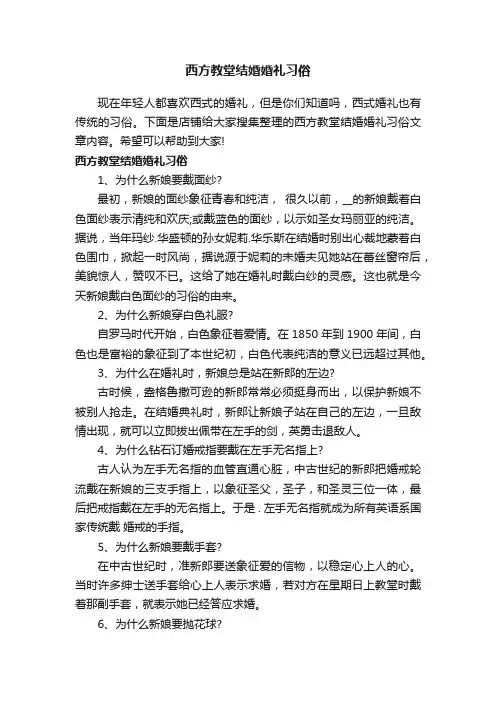
西方教堂结婚婚礼习俗现在年轻人都喜欢西式的婚礼,但是你们知道吗,西式婚礼也有传统的习俗。
下面是店铺给大家搜集整理的西方教堂结婚婚礼习俗文章内容。
希望可以帮助到大家!西方教堂结婚婚礼习俗1、为什么新娘要戴面纱?最初,新娘的面纱象征青春和纯洁,很久以前,__的新娘戴着白色面纱表示清纯和欢庆;或戴蓝色的面纱,以示如圣女玛丽亚的纯洁。
据说,当年玛纱.华盛顿的孙女妮莉.华乐斯在结婚时别出心裁地蒙着白色围巾,掀起一时风尚,据说源于妮莉的未婚夫见她站在蕾丝窗帘后,美貌惊人,赞叹不已。
这给了她在婚礼时戴白纱的灵感。
这也就是今天新娘戴白色面纱的习俗的由来。
2、为什么新娘穿白色礼服?自罗马时代开始,白色象征着爱情。
在 1850 年到 1900 年间,白色也是富裕的象征到了本世纪初,白色代表纯洁的意义已远超过其他。
3、为什么在婚礼时,新娘总是站在新郎的左边?古时候,盎格鲁撒可逊的新郎常常必须挺身而出,以保护新娘不被别人抢走。
在结婚典礼时,新郎让新娘子站在自己的左边,一旦敌情出现,就可以立即拔出佩带在左手的剑,英勇击退敌人。
4、为什么钻石订婚戒指要戴在左手无名指上?古人认为左手无名指的血管直通心脏,中古世纪的新郎把婚戒轮流戴在新娘的三支手指上,以象征圣父,圣子,和圣灵三位一体,最后把戒指戴在左手的无名指上。
于是 . 左手无名指就成为所有英语系国家传统戴婚戒的手指。
5、为什么新娘要戴手套?在中古世纪时,准新郎要送象征爱的信物,以稳定心上人的心。
当时许多绅士送手套给心上人表示求婚,若对方在星期日上教堂时戴着那副手套,就表示她已经答应求婚。
6、为什么新娘要抛花球?新娘抛花球意味着谁接到谁就快要结婚了,所以我们经常可以看到这样的场面:一群欣喜若狂的年轻人等待着新娘手中抛出的花球。
7、新郎也要抛东西吗?新郎抛袜圈同样寓意谁接到谁就快要成新郎了。
8、为什么在婚礼上要有结婚蛋糕?古罗马时代一对新人多在婚礼举行时,把蛋糕放在新娘头上敲碎来享用象征把婚礼的气氛推向高潮,更祈愿道贺的亲友分享到新人的幸福和喜悦。
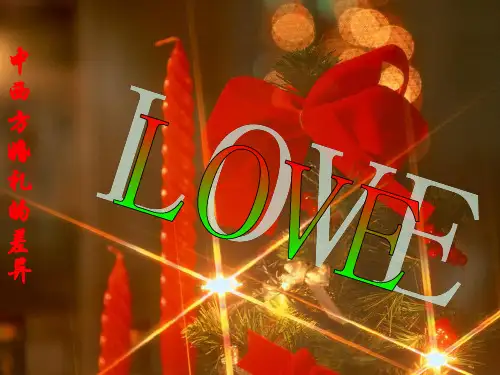
Wedding Customs Differencesbetween China and the WesternⅠ. IntroductionThe 21st century is dominated by science and technology, which makes the whole world develop quite rapidly. Along with the development of the global tendency, different nations increasingly communicate with each other. In order to promote a better understanding between different nations, it is worthwhile to know more about different cultures. Since wedding is a moment that the couple promise to go though the rest of their lives with each other. There is no doubt that the wedding day must be one of the most splendid and unforgettable days in one’s lifetime. Therefore this paper aims to explore the different cultures between China and Western countries from the point of view of wedding customs and will list the major differences of Chinese and Western wedding so as to find out the interior factors that result in the differences.There are a lot of differences between Chinese wedding customs and Western wedding customs from preparation stage for the wedding to the end of wedding. Chinese wedding customs are much more complex than Western wedding customs, especially in the wedding ceremony aspects. In the Chinese traditional wedding customs people stress more, for Chinese people are more conservative and traditional, but the open-minded Western people’s wedding is much simpler.Besides, their different thoughts, different religions and different attitudes to marriage influence their wedding customs much, too. Chinese people mostly believe in Buddhism but Westerners have faith in Christianity, which decide the palace where the wedding is held and how complex the whole process is. Chinese people’s marriage is relatively stable. Because Chinese people always consider marriage as one of the most important things in life. Westerners’ concepts of marriage are extremely different from Chinese. They believe that marriage is purely a private matter, and no one caninterfere.This thesis addresses the differences between Chinese wedding customs and Western wedding customs by analyzing the wedding procedures and the influences of different thoughts, attitudes and religions on the wedding customs. It is extremely important to understand the different cultures between China and Western countries, which will help us to correctly understand the words and deeds of Westerners in the intercultural communication, fully understand, and respect each other’s customs so as to get the best effect of communication.Ⅱ.The Differences of Wedding Customs between China and the West2.1. Pre-weddingIn china, the parents always prepare some dowry for their daughter. The bride’s dowry includes a scissor, a ruler, some sugar tablets, vases, a copper pot and a pair of shoes, which indicate fortune. There are also pairs of quilts, bed linen and pillows, some sets of clothes and so on, which means a good wish for their rich and nice life. Every item has its different meanings.At the bridegroom’s home, there are also many things to be prepared. At first they must tidy and layout the bridal chamber, and the whole chamber must be decorated with red things, such as red candles, red quilts. People paste congratulatory couplets and large red Chinese character meaning “Happiness”in English on the doorframes and walls. And then they need to prepare some food, fruit, tea, and wine on the table, which will be used at the night of the wedding. At the same time the bridegroom must prepare some money packaged in red paper bags to thank some people on the day of the wedding, such as his bride’s brother and people who helped him. People think the money in a red paper bag from the bridegroom will bring them good luck and nice life.In Western countries, when it comes to the preparations, we must talk about Something Old, Something New, Something Borrowed, Something Blue,2.2. Wedding2.2.1 Wedding LocationIn China, the wedding location usually is a better hotel around which the transportation is convenient, and the space is spacious. Because all kinds of ceremonies will be held there and many friends and relatives will be receipted there, the space must be enough big.While in the Western, in order to highlight the solemn and holy, the wedding is generally held in the church or other relatively quiet places in good order. Relatively speaking, the Western wedding is less exciting than the Chinese wedding. Whatdeserves to pay more attention is that the Westerners focus on the expression of emotion and pursuit the perfect combination of romance and reality.2.2.2 Wedding Dress。
西方婚礼体现的爱情观和价值观摘要:本文具体讨论了中国与西方在婚礼文化上的不同。
主要是通过对中西方婚礼风俗的不同进行分析对比.探讨在不同文化背景下、不同文化中所表现出来的民俗差异,探讨跨文化交际中爱情观和价值观中的不同差异。
关键词:婚俗文化、爱情观、价值观、跨文化交际一、中西方婚礼文化差异文化是同一群体对信仰、习俗、价值观念、行为进行交流、学习并代代相传的总积累。
在不同的生态或自然环境下,不同的民族创造了自己特有的文化。
也被自己的文化所塑造。
民俗就是民间风俗习惯.是人类社会长久形成的习俗惯制、礼仪、信仰、风尚的总和.是社会约定俗成的民间生活、文化模式。
民俗的内容繁杂广泛,我们可将它分为物质民俗、人生社会民俗、心意信仰民俗、游艺竞技民俗,包括衣食住行等物质生活方面的风俗习惯.个人在人生社会中所经历的礼仪习俗.如生死婚丧等.以及人类群体为适应生存和发展共同创造长期形成的习俗如人际交往和岁时节令民俗.民众间流行的各种崇拜心理观念、民间禁忌等等。
民俗生动地体现着一个民族的民众生活习惯、行为方式、伦理观念以及心理结构等方面的传统特点.是构成民众生活文化史的主体与核心。
民俗心理是民众心理结构中最深层、最隐蔽,同时也是最稳同的部分。
它是自远古传下来的.以民间信仰为核心的一种思维方式。
一个国家或民族的文化由表层文化和本质文化两个层次组合而成.前者记载在文献里,后者流传在民众生活中。
而民俗文化是民众生活中的本质文化。
是社会生活中最富情趣的领域,也是一个民族或一个地区文化传统、价值观念及生活方式的集中表现。
婚姻是人们结为夫妻关系的一种文化现象。
婚姻习俗是伴随着婚姻的产生而产生的.它展示了民族群体的社会生活面貌,以及审美观、伦理观、价值观、宗教观和民族心理的发展态势,是人类创造的文化积累和精神财富。
自古以来。
几乎在每一种社会文化中,都有举办婚礼的习俗.用婚礼将丈夫和妻子的关系公开确定下来,婚礼的形式也随着人类社会的进展不断地发生着变化。
世界各地结婚礼仪习俗盘点世界奇特婚礼习俗1、印度婚礼习俗:为了祭祀在印度教徒眼里,结婚是宗教责任,而最重要的是祭祀活动;而生出孩子的人才有资格祭祀献礼。
所以印度教徒结婚的时候丈夫念完祷告之余要对妻子说,是为了生育才娶的新娘2、丹麦婚礼习俗:秘密进行丹麦人相信公开招摇雨般的婚礼会招来邪恶,所以纵使长时间的婚礼准备,结婚的当天也要秘密进行,不过还有个习俗,就是婚礼上要打破结婚新人之间放置的啤酒桶,让未婚参与婚礼的女性捡拾碎片以求得好运3、德国结婚习俗:砸碗盆图吉利参加婚礼的宾客要带上瓷质的碗或者盆,并在婚礼上打破,为新人带来好运,与消解烦恼4、俄罗斯结婚习俗:叫苦不迭婚宴上只要有人大喊苦的时候,新人就要接吻,直到客人平息,而这样的叫苦会在婚宴上持续10多次,而是毛子们认为婚宴上的酒是苦的,而新人们的吻能让酒变甜5、法国结婚习俗:浪漫简单法国素来以浪漫著称,但是婚礼习俗却很简单,在一两个家人的陪同下完成订婚,再到指定时间进行大人物主持的简单结婚仪式就可以了,不过仪式完成还是要大摆宴席请客吃饭。
盘点世界各地婚礼习俗美国-------惊喜与浪漫传统:男士会选择特别的地点,突然向自己的爱人求婚,如要求未婚妻共赴烛光晚餐,或某一充满罗曼蒂克气息的场所。
美国的习俗是男方单膝跪地,向女伴献上戒指求婚。
通常由男方选择完全符合自己未婚妻品味和风格的戒指,但有时则由双方共同选择。
铂金钻戒最受欢迎,但也有人选择镶嵌蓝宝石、黄钻或祖母绿的18K黄金或18K白金戒指。
一旦宣布订婚,男女双方将通知各自的家人,并尽快开始筹备婚礼,随后才会选择结婚戒指。
结婚戒指由未婚夫妻共同选择,大部分情况下,结婚戒指均与订婚钻戒相互搭配。
德国------花好月圆,完美时刻传统:男方正式向女方父亲提亲,获未来岳夫的首肯后,其他人便不再有任何异议。
对许多女性而言,人生中最美妙的时刻,莫过于心爱之人手捧装着订婚钻戒的珠宝盒,单膝跪在自己面前。
因此,婚戒的选择至关重要,通常由男方自行决定。
浅谈中西方风俗习惯差异中西方的地域、历史背景不同,带来了人们思想、行为等各种差异。
我们只有不断学习、认知中西方的差异,才可以更好融入这个大千世界,繁荣昌盛。
下面简单地谈谈中西方在风俗习惯上的差异。
一、婚礼中体现中西方风俗差异中国在传统婚礼中,新娘一般穿者红色罗衣,头戴凤冠,上面还有一块红色丝巾。
而新郎就穿着红色的长马褂,头戴红色大沿帽。
新娘乘着大红花轿在后,新郎骑着马在前,随着红娘和迎亲队伍到新郎家中拜堂。
闹洞房是婚礼的高潮,新娘先回洞房等新郎,而新郎在外面招待客人,酒足饭饱后,新郎在一大堆人的簇拥下来到洞房。
众人就开始闹洞房了,新郎新娘在大家的起哄下做各种游戏。
这样整个婚礼就在一片笑声中结束了。
而西方国家(以美国为例子),他们的婚礼是以浪漫为主题的,传统的婚礼一般都在教堂举行,参加的对象有新娘、新郎及双方的亲朋好友,还有主婚的牧师。
婚礼上新郎身着黑礼服,新娘则穿着长白色结婚礼服,它象征着新娘的纯洁无暇。
新娘还带着面纱,因为在古时候,面纱被认为是可以避邪的。
在婚礼进行曲的音乐中,新娘挽着她父亲的右臂沿着过道,踩着猩红的地毯,缓缓走向圣坛(新郎已在圣坛边),后面跟着女傧相、花童及其他陪伴人员。
这时,新娘把手从父亲的手上拿开,牧师开始问新娘的父亲;“Who gives this woman to the man ?”新娘的父亲答话后,将女儿的右手递给牧师,牧师再将手递给新郎,然后新娘的父亲退下。
牧师问过新郎、新娘是否愿意结为夫妻,并得到肯定答复后,宣布他们为夫妻。
这对新人在牧师的引导下,双双宣读婚誓。
随着中国对外的开放程度越来越深,中国的婚礼习惯也受到了西方影响,例如:男女结婚的衣着服饰有了改变,现在女方不只是红色旗袍了,还会穿上洁白的婚纱。
在结婚当天,女方不在只是静静待这婚房,也会和男方一起迎接客人、敬酒等等。
二、日常交际过程中体现出来的中西方习惯差异中国人在与人交际时,讲求卑己尊人,把谦虚看作一种美德。
中西方结婚习俗差别英文版中西方结婚习俗差别英文版奇酷7502014-09-25优质解答In China,surnames are always given first.A man named as Wang Xin,for instance,should be called as Mr.Wang,instead of Mr.Xin.In western cultures,Surnames are given last.东方人的姓在前,西方姓在后,名在前.A married woman always retains her maiden name.However,this is different in westerncultures where a married woman usually take the last name of her husband.中国人结婚后保留自己的姓,西方女人一般跟丈夫姓Asian grooms pick up their brides before the wedding starts while it is unlucky in western culture for the groom to see the bride before the wedding starts.亚洲新郎婚礼前会去接新娘,西方文化说的是新郎新娘在婚礼前是不能见面的,会倒霉.Asian weddings are often festive in a banquet hall filled with high-spirited activities and handing out money while western weddings are quiet often celebrated in a church or park.东方婚比较热闹,有很多礼仪,像是给钱什么的,西方婚礼比较安静,没有收钱的习惯一般,在教堂,公园等等地方举行asian brides traditionally wear red while western brides wear white carrying something new,something old,something blue,something borrowed.中方新娘传统是穿红色,西方传统穿白色,要携带一样新的东西,一样旧的东西,一样蓝色的东西,一样借的东西.小颜626mFp2014-09-25中国有哪些传统节日?各有怎样的传统习俗和文化内涵中国有哪些传统节日?各有怎样的传统习俗和文化内涵三角梅ㄣ60392014-12-04优质解答春节(Spring Festival)中国民间最隆重最富有特色的传统节日,一般指除夕和正月初一.但在民间,传统意义上的春节是指从腊月初八的腊祭或腊月二十三或二十四的祭灶,一直到正月十五,其中以除夕和正月初一为高潮农历正月十五日,是我国汉族的传统节日元宵节.正月为元月,古人称夜为"宵",而十五日又是一年中第一个月圆之夜,所以称正月十五为元宵节.又称为"上元节".按中国民间的传统,在一元复始,大地回春的节日夜晚,天上明月高悬,地上彩灯万盏人们观灯、猜灯谜、吃元宵合家团聚、其乐融融. 清明节古时也叫三月节,公历四月五日前后为清明节,是二十四节气之一.在二十四个节气中,既是节气又是节日的只有清明. 清明节是中国重要的传统民俗节日之一,2006年被列入第一批国家级非物质文化遗产名录农历五月初五,俗称“端午节”,端是“开端”、“初”的意思.初五可以称为端五.农历以地支纪月,正月建寅,二月为卯,顺次至五月为午,因此称五月为午月,“五”与“午”通,“五”又为阳数,故端午又名端五、重五、端阳、中天、重午、午日,此外一些地方又将端午节称之为五月节、艾节、夏节. 中秋节是我国的传统佳节,与春节、端午、清明并称为中国汉族的四大传统节日. 农历九月九日,为传统的重阳节.重阳节又称为"双九节""老人节"因为古老的《易经》中把“六”定为阴数,把“九”定为阳数,九月九日,日月并阳,两九相重,故而叫重阳,也叫重九,古人认为是个值得庆贺的吉利日子,并且从很早就开始过此节日. 帮你挑了这点..如果还想要少点你自己挑着写吧...一些不重要的可以删掉!中国的传统节日礼仪习俗有哪些中国的传统节日礼仪习俗有哪些TA002032014-09-28优质解答春节春节代表着新的开始与新的希望,春节是中国民间传统中最为隆重和盛大的节日.历朝历代,无论是达官显贵,还是贩夫走卒,所有的中国人都有把春节看作是喜庆团聚的好日子.春节,古称元旦.据民间习俗,从腊月二十四起到新年正月十五闹元宵止都称春节.现在春节的庆祝活动一般从大年三十(二十九)开始.春节期间,家家户户清扫一新,贴春联、贴年画、守岁、放鞭炮、拜年等活动丰富多彩.扫尘:每年从农历腊月二十三日起到除夕止,我国民间把这段时间叫做“迎春日”,也叫“扫尘日”.扫尘就是年终大扫除,北方称“扫房”,南方叫“掸尘”.每逢春节来临,家家产户都要打扫环境,清洗各种器具,拆洗被褥窗帘,洒扫六闾庭院,掸拂尘垢蛛网,疏浚明渠暗沟,到处洋溢着欢欢喜喜搞卫生、干干净净迎新春的气氛.办年货:一到腊月,人们都要上街采办过年的物品,买年画,准备过年的春联.吃团年饭:团年饭意为一家团圆.腊月的最后一天要全家团聚吃一顿丰富的年饭.凡家中在外地工作或学习的家人都会尽可能赶回家团聚.这顿饭要吃得欢欢乐乐,菜肴吃食也具有吉利的象征意义,如鱼(年年有余)、整鸡(大吉大利)、青菜(清洁平安)、年糕(年年高)等.吃饭时,不要说丧气的、不吉利的话,不能失手打破碗碟杯盏,不要碰翻椅凳,因为这些会被视为不吉利的征兆.守岁:除夕之夜,灯火通明,家人围坐一起畅谈,长辈要将事先准备好的压岁钱分给晚辈,“岁”与“祟”谐音,晚辈得到压岁钱就可以平平安安度过一岁.除夕之夜,在我国北方家家都要包饺子.鞭炮迎新:“爆竹一声除旧,桃符万户更新.”古代燃放鞭炮是为了驱鬼祛邪,而如今则表示节庆欢乐,鞭炮越响,来年家庭财源会越兴旺.拜年:新年伊始,人们走亲访友,登门拜年互致节日祝贺,联络感情.拜年的习俗各地并不相同,但一般初一上午不走亲访友.出去拜年要穿戴整洁.出门遇到熟人、朋友要恭贺新年,说些吉利话,即使是遇见平时与之开惯了玩笑的人也不能随便开玩笑.见到长辈要行拱手礼.走亲访友要携带礼物.过年时,招待宾客的食物有讲究,通常以谐音讨口彩,比如吃柿子苹果,喻意事事平安;吃年糕则意味着年年高升.春节期间,人们还经常走上街头,参加舞狮子、耍龙灯、踩高跷、逛花会等娱乐项目.春节期间也要注意喜庆有度.这一期间热闹的时候比较多,不应为了自己开心而打扰了邻居们休息.春节不仅要拜年,有时候也要恭喜人家喜迁新居.看看新房的格局,参谋一下崭新的家具,如果您是访客,也会有这样的“猎奇”心理.但参观前应该征得主人的同意,等待主人的邀请,而不要主动直接提出参观请求,令主人不好拒绝.如果受到主人邀请参观,也要跟在主人身后,不要自己去打开房间门,尤其是卧室和主卫的门.因为有很多城市都不允许燃放烟花,有的人也没有放鞭炮的喜好,所以过年送礼最好不要送鞭炮.元宵节农历正月十五是一年中第一个月圆之夜,叫元宵节,又称“上元节”或“灯节”.自唐朝开始,民间就有元宵之夜观灯的风俗.现在元宵节有很多节俗活动.吃元宵是元宵节最主要的活动.古时候人们把元宵这种食品叫汤圆、汤团或团子.元宵的形状是圆形,又含着一个“圆”字的同音字,象征着团圆、美满、吉祥、和睦的家庭,所以人们多取其意,这一天要吃元宵.灯会在夜间举行,一般从正月初十开始就行动起来,人人动手,家家户户扎花灯、点花灯,特别是到了元宵节的夜晚时分,更是举烛张灯,结彩为戏,供人观赏,所以元宵节又称“灯节”.在明清时,花灯的样式最为繁多,数不胜数.现在政府、民间都会组织大型灯会.端午节农历五月初五为端午节,又称端阳节、午日节、五月节、艾节、端五、重午、午日、夏节.相传爱国诗人屈原在农历五月初五这天怀抱石头投汨罗江自尽,两岸百姓知道后,纷纷划船打捞他的尸体,并向江中投放粽子,使鱼虾饱食后不吃他的尸体.此传说历代沿袭下来,演变成如今端午节吃粽子、赛龙舟的习俗.节日的习俗礼仪有:挂菖蒲、艾叶:民间特别是农村家庭,门窗上要挂菖蒲、艾叶,用以驱鬼辟邪保平安.虽然这是迷信,但因艾叶、菖蒲具有杀虫、驱寒、消毒之用,故这一习俗一直保持下来,城乡许多家庭都在这一日采集艾叶,以备常年家用.吃大蒜头、喝雄黄酒:端午节,家庭要备一桌丰盛于平日的饭菜,全家共享.这一餐习惯上要吃大蒜头煮肉,喝雄黄酒.大人会在不能喝酒的孩子额头上沾上雄黄,或画一个“王字”,去病消灾.这种习俗在现代城市已逐渐被人遗忘.吃粽子:端午节吃粽是我国民间长久盛行的习俗.早在1300多年前的唐朝,吃粽已经流行.在湖南岳阳、益阳一带,端午还兴吃麻花,当地把它称“油绞”,女婿去丈母娘家拜节,也要提一串麻花.据说,吃麻花也是为了纪念屈原.赛龙舟:当时楚人因合不得贤臣屈原死去,于是有许多人划船追赶拯救,借划龙舟驱散江中之鱼,以免鱼吃掉屈原的尸体.竞渡之习,盛行于吴、越、楚.佩香囊:端午节小孩佩香囊,不但有避邪驱瘟之意,而且有襟头点缀之风.香囊内有朱砂、雄黄、香药,外包以丝布,清香四溢,再以五色丝线弦扣成索,作各种不同形状,结成一串,形形色色,玲珑夺目.中秋节农历八月正好在秋季的中间,古人谓“仲秋”,八月十五又在“仲秋”之中,所以称“中秋”,恰逢此日又与月有关的“中秋节”就有了许多别称:“八月节”、“八月半”、“月节”、“月夕”,继而引申为以圆月为象征的“团圆节”.人们邀请亲朋好友,夜饮玩月,连回娘家的媳妇这天都必须返还夫家.中秋晚上,我国大部分地区有烙“团圆”的习俗,即烙一种象征团圆、类似月亮的小饼子,即“月饼”.饼内包糖、芝麻、桂花和蔬菜等,外压月亮、桂树、兔子等图案.祭月之后,由家中长者将饼按人数分切成块,每人一块,如有人不在家即为其留下一份,表示阖家团圆.重阳节农历九月九日,是我国传统的重阳节,又名重九节、登高节、菊花节、茱萸节.我国古代把九定为阳数,农历九月九日,月日并阳,两阳相重,两九相叠,故名“重阳”,又名“重九”.每到这一天,人们出游登高,赏菊花,饮菊花酒,佩茱萸,吃重阳糕.时至今日,一些地区仍保存着这种风俗.政府还把重阳节定为“敬老节”,向老年人表达敬意之情并帮助他们解决困难等.冬至与腊月冬至是我国的一个重要节气,时间是12月22日或23日.过了冬至,我国大部分地区将进入最寒冷的时期.俗话说:“冬至大如年.”古代,在这一天有祭天、祭祖、拜贺、食百味馄饨等习俗,今天人们也在这一天祭祀先祖.腊月为腊月初八,有吃“腊八粥”的风俗.西方国家的节日习俗与简介分享|2013-04-14 15:29匿名|浏览2127 次西方国家的节日习俗与简介,每个节日介绍100字左右,要不同国家的,每个国家3个左右的节日就好。
中西传统婚俗礼仪的差异所在由于文化底蕴的不同,中西方的婚礼也有着较大的差别,但是随着改革开放的到来,中西方的婚礼已经渐渐融和,现在的婚礼,既有西方的原素,也不会缺乏中式的特色。
下面是为大家准备的中西传统婚俗礼仪的差异所在,希望可以帮助大家!中西传统婚俗礼仪的差异所在(一)婚礼地点对于我们中国人来说,婚礼要办的隆重热闹,邀请众多的亲戚朋友,所以婚礼举行的地点一般都选在交通方便、空间宽敞的院落或酒店。
西方婚礼突出庄重和圣洁,婚礼一般都是在教堂,或其他较为安静的地方举行,婚礼井井有条,但是相对来说就不如中国婚礼那么热闹。
(二)婚宴中西方的婚宴也有很大不同。
在中国,一般都在婚宴所在地举办结婚典礼。
传统的婚宴的酒席是一场非常盛大、隆重的宴席,通常在中午举行,持续三天。
另外还设有一些余兴节目。
对于新郎的父母而言,更是要宴请其所有的亲朋。
宴席上,人们只是吃、喝、聊天,饭后各自回家。
在西方国家,婚宴通常是在教堂的结婚典礼结束之后举行。
婚宴中通常伴随着舞会,婚宴舞会可能会有一些特别的模式。
宴会会在互相敬酒与庆祝中进行,一直到新人们坐上车子离去为止。
新人会在家人朋友的欢送下开始蜜月旅程。
通过以上几个方面的比较我们可以看出,西方的婚俗更为开放、浪漫、自由,而中国的婚俗更为严谨、庄重、繁琐。
但是,中西方的婚俗也有相似的地方。
例如,中国古代有抛绣球迎亲的习俗;而西方的新郎新娘在教堂举行婚礼后,会把手中的鲜花抛向空中,如果有人接到的话就预示着他将很快结婚。
中西方婚礼上都有一位主持,西方国家的通常是神父或牧师,而中国则是专门的婚庆司仪,其主要任务就是使婚礼更加热闹,亲戚朋友更加开心。
中西传统婚俗礼仪的差异西方教堂试婚礼,有神父宣读誓词中国婚礼需要拜天地、拜高堂、夫妻对拜中西方婚礼的差别-中西方国家喜宴形式不同中式喜宴的酒席很大一部分的内容是亲朋好友热闹地聚在一起进餐,另外还设有一些余兴节目。
在宴席中间新娘一般换1至2套衣服,迎宾时新娘先穿白色婚纱,敬酒时再换上极富个性色彩的衣服。